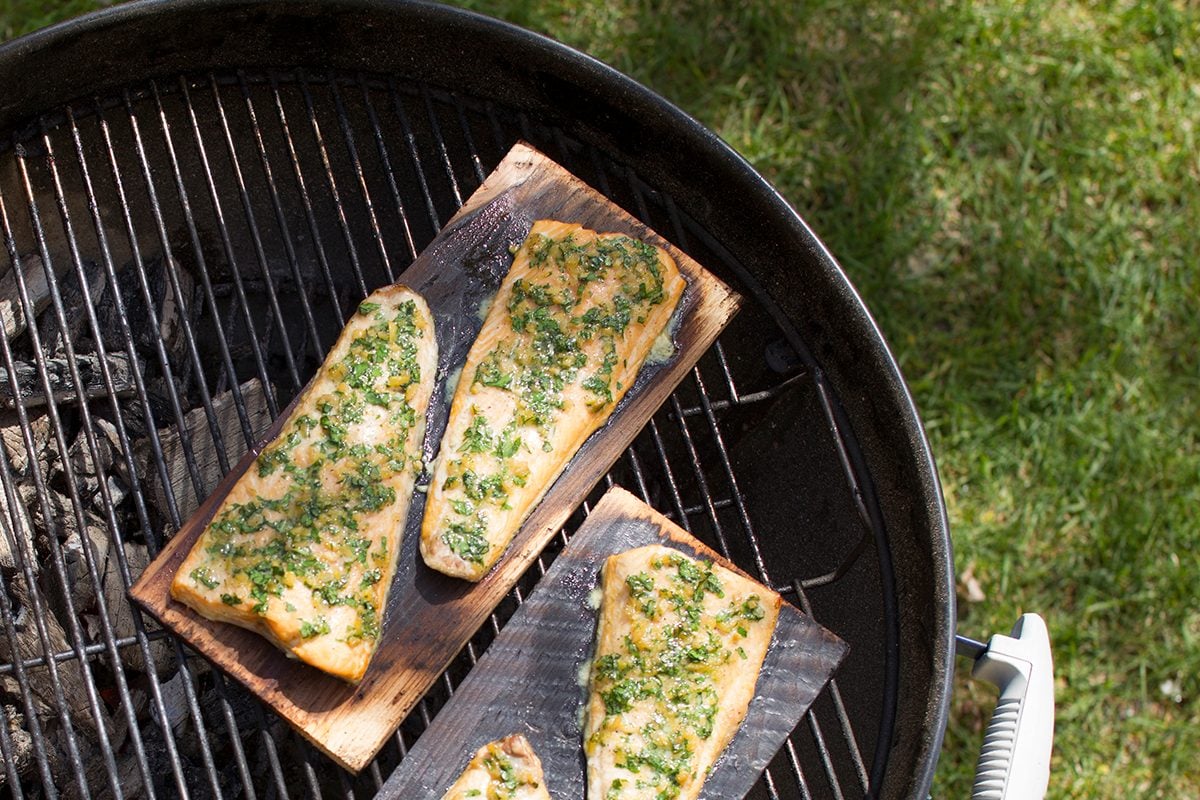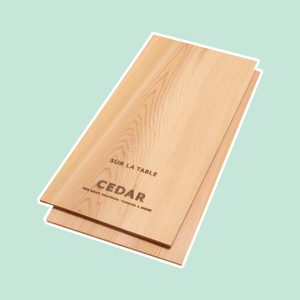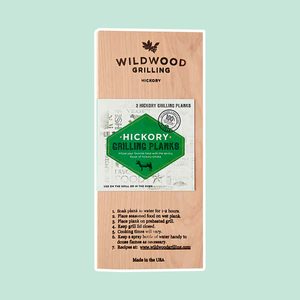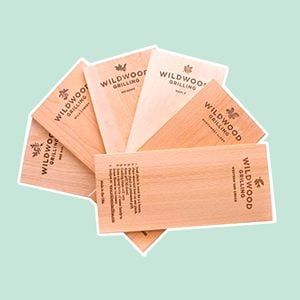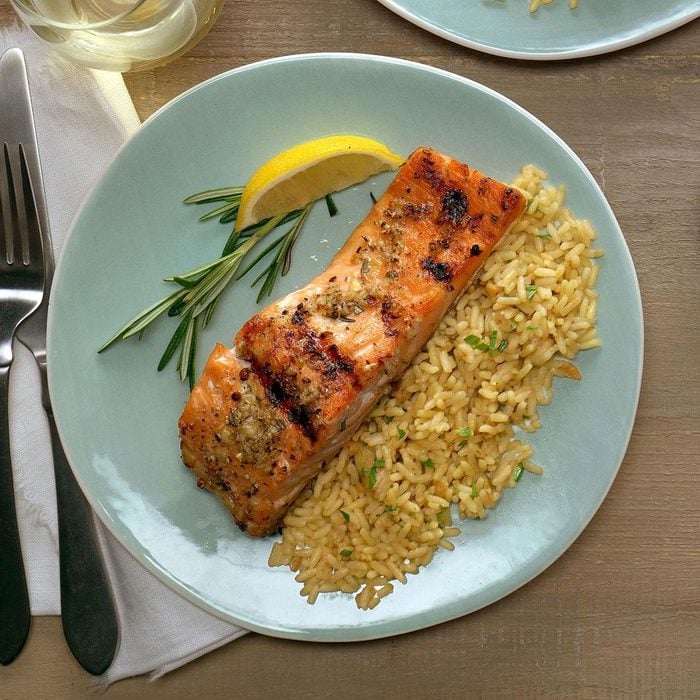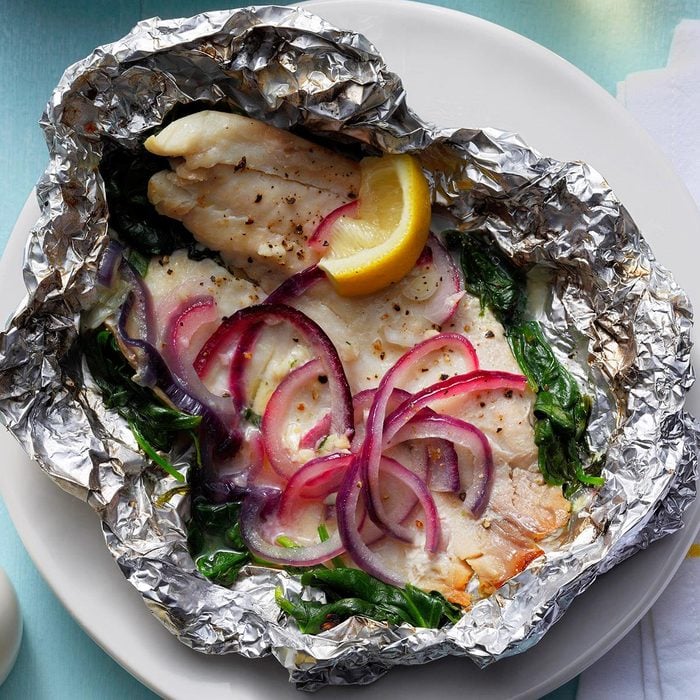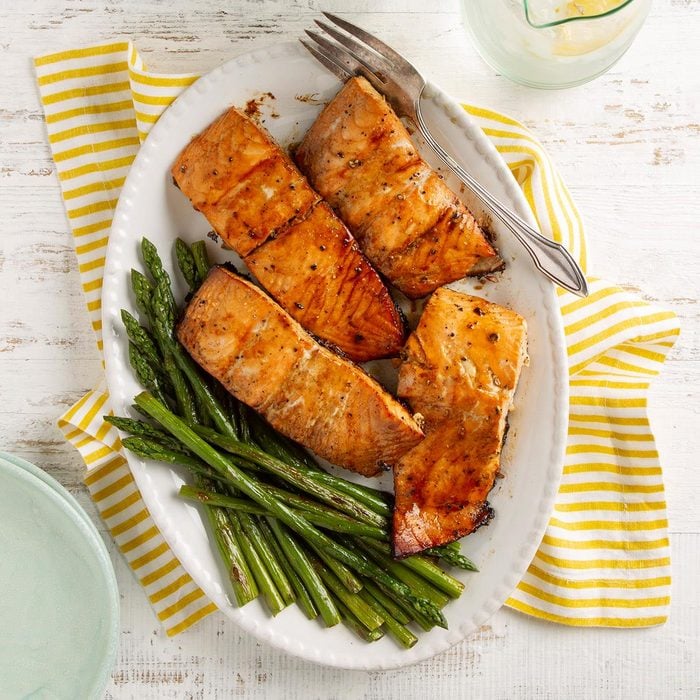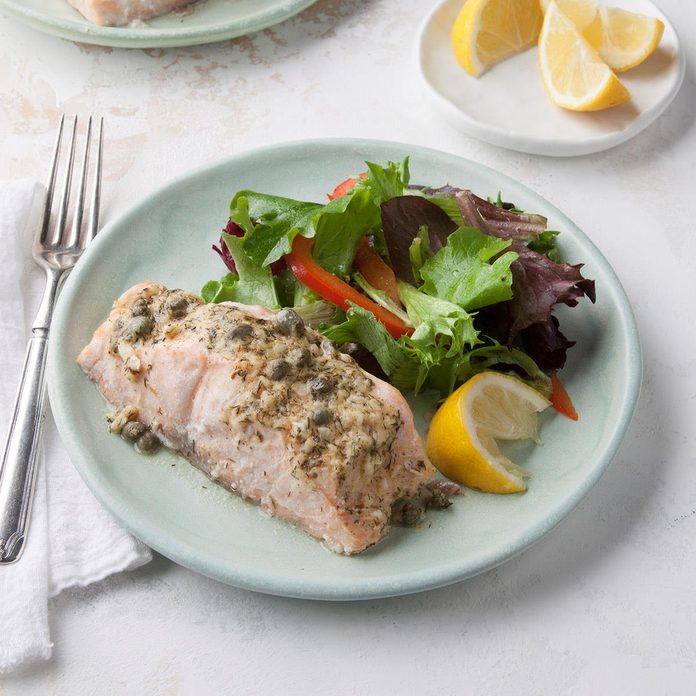Bright glowing coal, a flickering flame and the satisfying sizzle of meat. For many people, these are the signs a grilling session is in full swing. Folks from the Pacific Northwest, however, will tell you there’s another cue: the smell of charred cedar. Growing up just outside Seattle, I’d spend cool summer evenings sitting on the patio watching my father grill salmon directly on a wooden plank. The smoked cedar would stick to my clothes for days, but it was worth it for the delicious family dinners.
Now that I’m older, I realized that I inherited zero grill skills from my pop. Looking to recreate this nostalgic technique in my own backyard, I asked expert food editor (and resident grill master) James Schend to break it down to the basics:
What Is Plank Grilling?
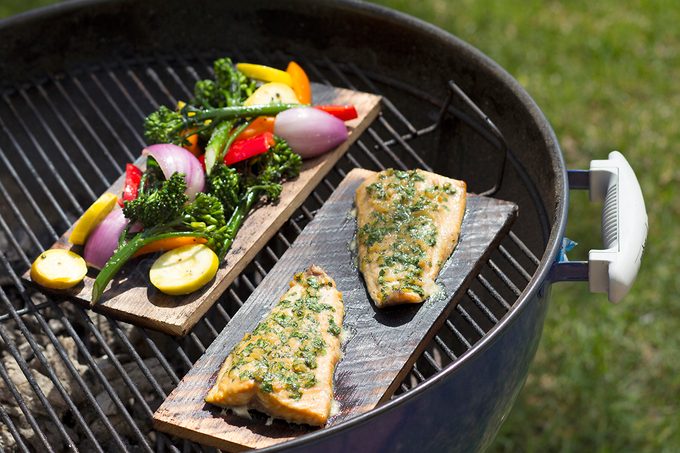 Taste of Home
Taste of Home
Plank grilling, also known as planking, is a method in which food is placed on a wooden board that has been set over indirect heat on a grill. It’s the best way to ensure that your dish gets a deep, wood-smoked flavor. Plank grilling totally beats out the standard woodchip routine because the skin of your fish (or chicken or veggies) directly contacts the charred plank. That being said, the flavor will vary depending on the type of wood you choose.
What Can You Make on a Cedar Plank?
When it comes to cedar plank grilling, fish is the most common pairing, however, you can grill nearly any protein or veggie with a plank. Try grilling steaks, chicken, pork, tofu or a handful of vegetables. Be sure to keep different meats on separate planks. Veggies of all kinds can share a plank, but don’t let veggies and meats share one.
How to Choose the Right Plank
Many cooking stores will sell pre-cut wood planks made especially for plank grilling. The flavor is up to you. Cedar, cherry, hickory, pecan, maple, apple and alder work well. Cedar planks, however, are the most popular.
When it comes to choosing planks based on flavor, think of some of your favorite proteins, like hickory-smoked salmon or applewood-smoked bacon. Those will give you some ideas on the flavors you may like. If you’re unsure, invest in a variety pack of planks and do some experimenting.
Wait, Won’t the Wood Catch on Fire?
It doesn’t take a veteran griller to realize that wood burns over an open flame. Before you fire up the grill, you’ll need to treat the plank to a long soak in water. This helps prevent the wood from catching on fire while you cook. You’ll still need to watch for occasional flare-ups, so take precautions and keep a water bottle handy while you grill.
Can You Reuse the Plank?
When it comes to reusing planks, it depends on the condition of the plank after grilling. If the cedar plank is thoroughly charred, you’re best scrapping it and starting fresh next time.
If you find that the plank is still in good condition (not a lot of char), you can reuse it according to Wildwood Grilling. Wash the plank with hot water (don’t use soap, though) and store in the freezer. Be sure to use that plank with the same protein or ingredients the next time you grill. So use that trout plank for fish every time and your veggie plank with veggies next time, too.
How to Make Plank-Grilled Fish
If you’re looking to start cedar plank grilling, start with a good recipe. This plank-grilled trout recipe is a favorite in our Test Kitchen.
You’ll need:
- 2 grilling planks
- 2 tablespoons butter, softened
- 2 tablespoons minced fresh gingerroot
- 4 teaspoons each minced fresh basil, cilantro and parsley
- 1 tablespoon honey
- 2 teaspoons lemon zest
- 1/4 teaspoon kosher salt
- 1/8 teaspoon pepper
- 4 trout fillets (6 ounces each)
Step 1: Prepare the Planks
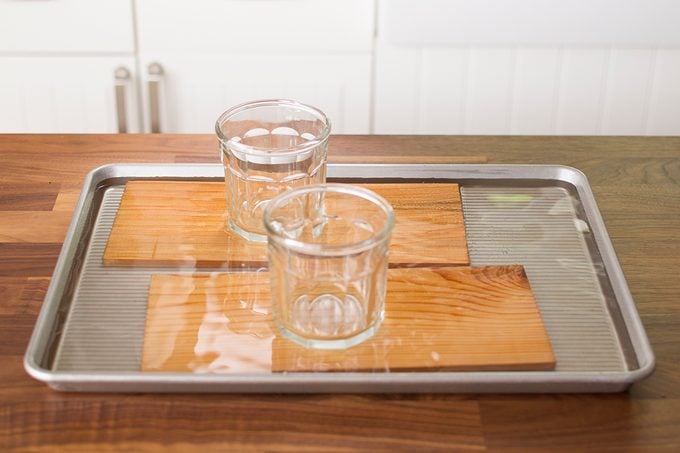 Taste of Home
Taste of Home
Before we begin, examine the planks to make sure they’re splinter-free. See a few pointy sticklers? Don’t panic. Give the wood a quick brush with sandpaper until smooth.
Now it’s tub time for your planks. Soak the boards in water for at least one hour (though three or four is better). The best way to soak your planks is to submerge the wood in a baking dish or rimmed sheet pan. Use a heavy can to keep them from floating. Flip occasionally to make sure they’re evenly soaked.
Test Kitchen tip: For more flavor, try adding wine or apple juice to the water.
Meanwhile, combine butter, ginger, herbs, honey, lemon zest, salt and pepper in a small bowl. This is what we’ll use to coat the trout.
Step 2: Fire Up the Grill
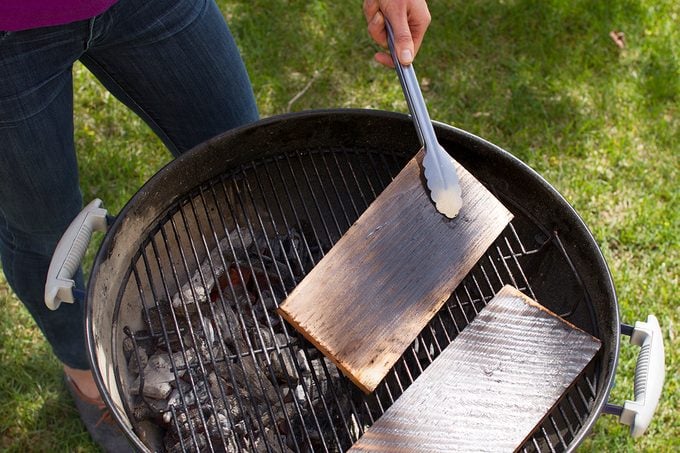 Taste of Home
Taste of Home
Let’s get grilling. You’ll want to prepare one side of the grill for direct heat and the other side for indirect. If you’re working with charcoal, use a chimney starter to corral your hot coals on one side of the grill. Direct heat means the zone above the coals.
Place your pre-soaked planks on the grill over direct medium heat. (For charcoal, you’ll know it’s reached medium heat if you can comfortably hold your hand five inches away from the grill for five to seven seconds.) Cover and let the plank heat for three minutes. Some light smoke should begin to emerge from the wood. You’ll know it’s ready when the plank begins to blacken
Test Kitchen tip: Slightly charring the planks gives the dish a deeper flavor. Prefer your wood less toasty? Skip this step and begin cooking over indirect heat.
Step 3: Grill the Fish
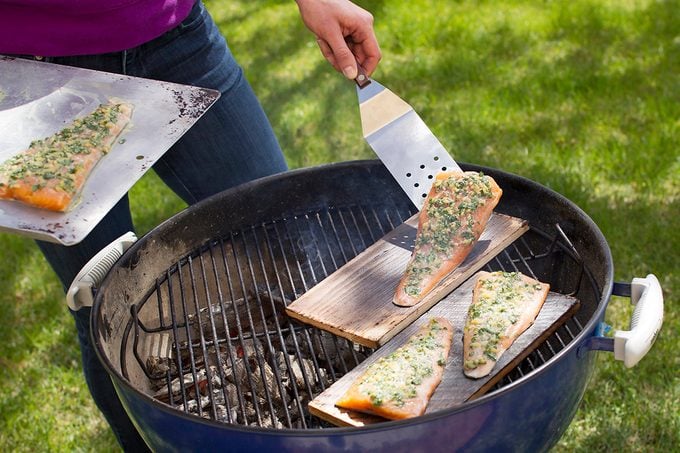 Taste of Home
Taste of Home
Using a pair of long-armed tongs, carefully flip the planks over so the blackened side faces upward. Move the planks to indirect heat.
Spread the ginger-herb spread over the flesh side of the fillets. Then place the fish on the planks, skin side down. Grill, covered, over medium heat for 10 to 15 minutes or until fish flakes easily with a fork.
Test Kitchen tip: Resist the urge to flip the fish after you’ve set it on the plank. Close the lid, sit back and let it cook.
Step 4: Enjoy!
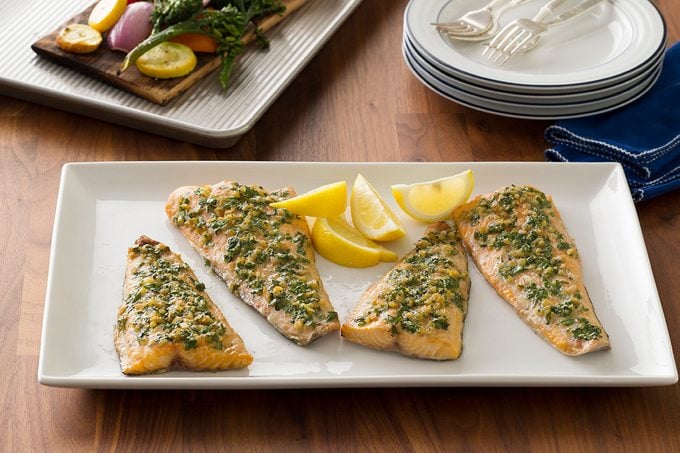 Taste of Home
Taste of Home
Your tender, smoky fish is ready for its debut. Transfer the planks to a pretty platter and serve. Your guests will be impressed by the plating-but they’ll love the flavor even more. One bite and you’ll want to plank grill all year round.
Even More Ways to Love Plank Grilling
Don’t limit yourself to trout. Most sturdy fish are great for plank grilling. Try salmon, bluefish, swordfish or wild striped bass. Looking for more? You can also grill chicken, pork, scallops and veggies on the plank, too.
Time to move on to the next course. Wrap up your meal with one of our top 10 grilled desserts.
Try More Grilled Fish Ideas with Your Cedar Plank
Grilled Salmon FilletsThe grill is a perfect cooking method for salmon. The smokiness is a subtle way to amp up salmon’s mild flavor, and the high heat creates a delicious charred finish. —Lindsay Mattison, Hillsboro, Oregon
Grilled Salmon SteaksThis is a terrific way to fix grilled salmon steaks, and it's so easy to do. The marinade mellows the fish flavor, and the dill sauce is a wonderful complement. I once served this recipe to 12 people from the Pacific Northwest who declared it was the best salmon they'd ever eaten! —Deb Essen, Victor, Montana
Spicy Plum SalmonI created this sweet and spicy salmon after being challenged to use healthier ingredients. The fresh plum sauce really complements the smoky grilled fish. —Cheryl Hochstettler, Richmond, Texas
Marinade for SalmonThis easy marinade for salmon adds a ton of flavor, whether grilled, pan-seared, broiled, baked or popped in an air fryer.
Here is a list of some
grilled salad recipes to serve with a side of grill marks.
Halibut Fish TacosHalibut fish tacos—sitting atop lettuce and tortillas and dressed with mango salsa—make a warm-weather meal that's quick, colorful and full of nutrients. Add any taco toppings you like.
Steamed Tilapia in Wine SauceI developed this recipe while working at a local winery. Fast and easy to prepare, it became an instant classic at my house. I use a lively dry pear wine in the sauce and recommend avoiding those wines that are sweet or semisweet. —Tenneille Brewer, Fayette, New York
Grilled Salmon in FoilGrilled salmon in foil is one of the easiest, fastest ways to make dinner with hardly any mess! Salmon steams inside the foil packet, while tomatoes and onions soak up the curry powder used to season the salmon.
Grilled Barbecued SalmonFor a beautiful blend of sweet and spicy, this salmon is grilled and basted with barbecue sauce enhanced by brown sugar and hints of chili, soy sauce and lime.—Country Woman Test Kitchen
Tilapia Florentine Foil PacketsI love fish and serving healthy food to my family. This is a winner in my house! —Shanna Belz, Prineville, Oregon
Bourbon-Glazed SalmonThis bourbon-glazed salmon is ready in minutes and requires only a handful of ingredients. Pair it with a green salad and couscous to have the perfect meal. If you don't like the taste of bourbon, you can use cola or brewed coffee. —Trisha Kruse, Eagle, Idaho
Grilled Salmon FilletGrilling salmon is a fantastic way to enjoy this rich, buttery fish—and our recipe makes it incredibly easy. In just 25 minutes, you'll create a perfectly seasoned, slightly smoky-flavored grilled salmon fillet.
Martha's Fish TacosWe can’t get enough barbecued fish at our house. This recipe can be made ahead and served cold, or you can eat it hot off the grill. It’s fantastic either way! —Martha Benoit, Proctorsville, Vermont
Cedar Plank Salmon with Blackberry SauceHere's my go-to entree for a warm-weather cookout. The salmon has a rich, grilled taste that's enhanced by the savory blackberry sauce. It's a nice balance of sweet, smoky and spicy. —Stephanie Matthews, Tempe, AZ
Grilled Mahi MahiInstead of grilling the usual hamburgers or chicken breasts, prepare this grilled mahi mahi and reel in raves! —
Taste of Home Test Kitchen
Grilled CatfishGrilled catfish boasts a delicious flavor, especially when it's infused with spices and served with lemon and parsley.
Grilled Tuna SteakThis grilled tuna steak is a quick and delicious dinner recipe that comes together in 10 minutes. Marinated in a blend of lemon juice, olive oil, garlic and thyme, it's an easy meal to make during summer grilling season.
Grilled Halibut with Blueberry SalsaGive halibut a new summery spin. The salsa may seem sophisticated, but it’s really a cinch to prepare. —Donna Goutermont, Juneau, Alaska
Grilled Tilapia with MangoHere's a new twist on tilapia that I created for my wife. She enjoys the combination of mango with Parmesan. Somehow it tastes even better outside on the deck with a cold glass of iced tea. —Gregg May, Columbus, Ohio
Maple-Balsamic SalmonI have a few good recipes for family-favorite, heart-healthy salmon, but this one is always a hit. I serve it this way at least once a week and sometimes more! —David Krisko of Becker, Minnesota
Grilled Campfire Trout DinnerYour fresh catch will taste even better with this simple treatment that keeps the fish moist. Carrots are an excellent accompaniment; cook up in a separate foil packet. —Wendy McGowan, Fontana, California
Firecracker Grilled SalmonLet this sensational firecracker salmon perk up dinner tonight. With a super flavorful glaze that kicks you right in the taste buds, this weeknight dish is anything but boring. —Melissa Rogers, Tuscaloosa, AL
Tuna Teriyaki KabobsI love to barbecue but don't always want a heavy dinner. These are perfect in the spring, and you'll have room for dessert! —Holly Battiste, Barrington, New Jersey
The Ultimate Fish TacosSavor these delicious paprika-spiced mahi mahi tacos with a tangy twist of salsa verde and fresh vegetable toppings in just 30 minutes.
Lemon-Dijon Grilled Salmon Foil PacketMy family enjoys this healthy salmon recipe very much, which makes it a winner in my book. The capers really give it a burst of flavor. And since the salmon are grilled in foil, there's almost no cleanup! —Bonnie McGuire, Sunnyvale, California
Grilled Fish FAQ
What fish is best for grilling?
The best types of fish for grilling are thick and firm like salmon, sea bass and halibut. This lowers the chances of your dinner falling apart and slipping through the grill grates. Opt for types of fish that have a mild flavor because they will soak up flavors from your chosen seasonings or marinade recipes. Finally, look for fish with a higher fat content because it will withstand high heat and stay moist.
Do you need to flip fish when grilling?
Yes, plan to flip your fish once while grilling. You'll want to grill each side for three to four minutes for a 1-inch thick fish filet. Be patient when flipping your fish. Allow it to naturally release from the grill grates, rather than forcing the flip. This helps your fish stay together rather than falling apart. Seasoning your grill grates is another useful tip to keep them nonstick (just like seasoning a cast-iron skillet!).
What should you serve with grilled fish recipes?
For grilled white fish, go with tried and true side dishes like potato pancakes or hush puppies. Seasoned white rice or lemony orzo pasta salad elevates salmon and tuna recipes. Grilled vegetables and crunchy coleslaw recipes help vary the textures and colors on your backyard barbecue spread too.



















